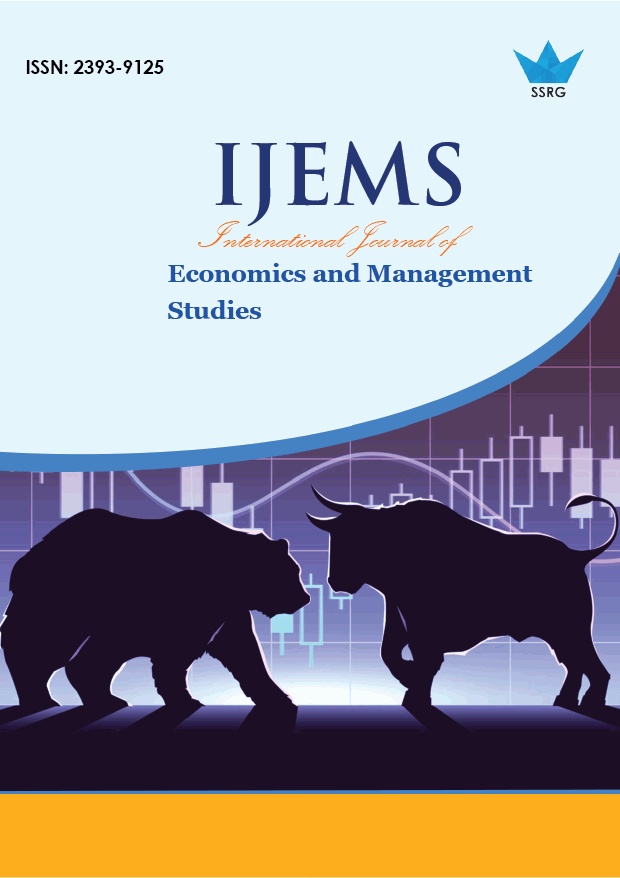Workers’ Remittance and Their Effect on the economic growth using HarrodDomer concept: an Empirical Analysis of Bangladesh

| International Journal of Economics and Management Studies |
| © 2017 by SSRG - IJEMS Journal |
| Volume 4 Issue 7 |
| Year of Publication : 2017 |
| Authors : Md Kamrul Hasan Maruf, Md. Moniruzzaman Muzib |
How to Cite?
Md Kamrul Hasan Maruf, Md. Moniruzzaman Muzib, "Workers’ Remittance and Their Effect on the economic growth using HarrodDomer concept: an Empirical Analysis of Bangladesh," SSRG International Journal of Economics and Management Studies, vol. 4, no. 7, pp. 26-31, 2017. Crossref, https://doi.org/10.14445/23939125/IJEMS-V4I7P106
Abstract:
Expatriate workers remittance payments are increasingly becoming a significant source of major international financial resources for many developing countries like Bangladesh. This paper investigates the causal link between remittances and economic growth in Bangladesh for the long run by using available annual data (1981-2014). From HarrodDomer model we know that economic growth can be increased by increasing domestic saving resources. To justify the impact of remittance on domestic saving we here use fixed capital formation as domestic saving and estimates the long run relationship between fixed capital formation and remittance. Interestingly we find a positive relationship between fixed capital formation and remittance which implies that remittance payments from migrant workers has positive impact on domestic saving and it can supplement domestic investment funds to enhance the capacity of the economy to grow.
Keywords:
Remittance, domestic savings, capital formation and economic growth.
References:
1. Agu, Chukwuma. "Remittances for growth: a twofold analysis of feedback between remittances, financial flows and the real economy in Nigeria." Paper for Presentation at the African Econometric Society Conference (Abuja. 2009.
2. Ahortor, C. R. K. "Adenutsi, DE (2009) The Impact of Remittances on Economic Growth in Small-Open Developing Economics." Journal of Applied Sciences 9.18: 3275-3286.
3. Amavilah, Voxi Heinrich S. "Domestic resources, governance, global links, and the economic performance of Sub-Saharan Africa." (2008).
4. Anyanwu, John C., and Andrew EO Erhijakpor. "Do international remittances affect poverty in Africa?." African Development Review 22.1 (2010): 51-91.
5. Barajas, Adolfo, et al. "Do workers' remittances promote economic growth?." (2009).
6. Chami, Ralph, Connel, Fullenkamp, and Samir Jahjah. "Are immigrant remittance flows a source of capital for development?." (2003).
7. Glytsos, Nicholas P. Dynamic effects of migrant remittances on growth: an econometric model with an application to Mediterranean countries. No. 74. Centre of Planning and Economic Research, 2002.
8. Griffith, Ronnie, et al. "Remittances and Their Effect on the Level of Investment in Barbados." Journal of Public Sector Policy Analysis 2 (2008).
9. León‐Ledesma, Miguel, and MatloobPiracha. "International migration and the role of remittances in Eastern Europe." International Migration 42.4 (2004): 65-83.
10. Rao, B. Bhaskara, and GaziMainul Hassan. "A panel data analysis of the growth effects of remittances." Economic modelling 28.1 (2011): 701-709.
11. Fajnzylber, Pablo, and J. Humberto López. "The development impact of remittances in Latin America." Remittances and Development (2008): 1.
12. Pradhan, Gyan, MuktiUpadhyay, and Kamal Upadhyaya. "Remittances and economic growth in developing countries." The European journal of development research 20.3 (2008): 497-506.
13. Catrinescu, Natalia, et al. "Remittances, institutions, and economic growth." World Development 37.1 (2009): 81-92.

 10.14445/23939125/IJEMS-V4I7P106
10.14445/23939125/IJEMS-V4I7P106